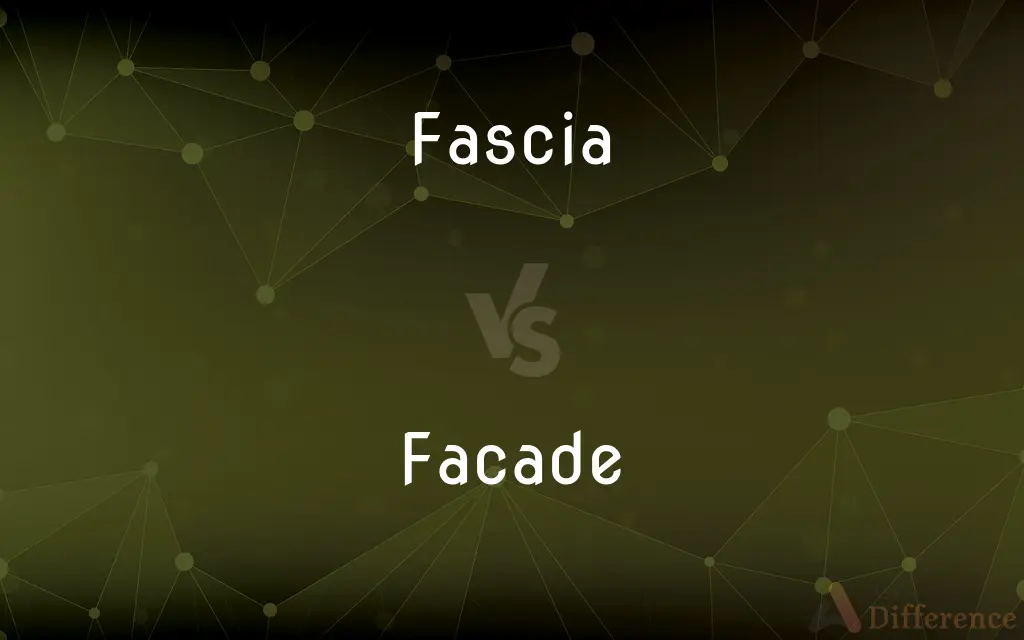Fascia vs. Facade — What's the Difference?
By Tayyaba Rehman — Updated on December 27, 2023
'Fascia' refers to a band or sheet of connective tissue, primarily in the body, or an architectural element covering the ends of rafters. 'Facade' is the face or front of a building, especially the main or front side.

Difference Between Fascia and Facade
Table of Contents
ADVERTISEMENT
Key Differences
'Fascia' in anatomy refers to a layer of fibrous tissue that encloses muscles and organs, playing a vital role in movement and flexibility. In architecture, it describes a horizontal band or panel at the exterior of a building, often at the roofline. 'Facade', however, specifically refers to the exterior front face of a building, representing its style and design.
Fascia in the human body provides structural support and compartmentalization for muscles and organs. Architectural fascia serves as a decorative or protective band on the exterior of a building. A facade, in contrast, is about the aesthetic and architectural appearance, often designed to make a statement or provide a certain character to the building.
In medical terms, fascia plays a critical role in the structural integrity and movement of the body. In construction, fascia can help protect the building from weather elements and enhance its visual appeal. Facades are essential in defining the architectural style of a building, from classic to modern designs.
Fascia, both in anatomy and architecture, is more related to function and structural necessity, whereas a facade is primarily concerned with the look and external impression of a building.
To summarize, fascia is associated with structure and support, both in the human body and in building construction. Facade, conversely, pertains to the outward appearance, style, and design of a building's front.
ADVERTISEMENT
Compare with Definitions
Fascia
An architectural element at the end of rafters or roofing.
They painted the fascia of the house in a bright color.
Facade
The main front of a building, especially an imposing or decorative one.
The grand facade of the theater was a landmark in the city.
Fascia
A band of connective tissue covering muscles and organs.
The fascia in her leg was strained during the workout.
Facade
The front face or exterior of a building.
The facade of the old building was beautifully restored.
Fascia
A flat band or surface on a building's exterior.
The new store had its name displayed on the fascia.
Facade
The face of a building, especially when regarded as architecturally significant.
Architects debated the best way to preserve the historic facade.
Fascia
A fascia (; plural fasciae ; adjective fascial; from Latin: "band") is a band or sheet of connective tissue, primarily collagen, beneath the skin that attaches, stabilizes, encloses, and separates muscles and other internal organs. Fascia is classified by layer, as superficial fascia, deep fascia, and visceral or parietal fascia, or by its function and anatomical location.
Facade
An outward appearance maintained to conceal a less pleasant reality.
She maintained a cheerful facade despite her struggles.
Fascia
A detachable covering for the front part of a mobile phone.
Facade
A decorative, front-facing part of a building.
The facade featured intricate carvings and statues.
Fascia
A board or other flat piece of material covering the ends of rafters or other fittings
A further piece of chipboard acts as a fascia to disguise the ceiling fixtures
Facade
The face of a building, especially the principal face.
Fascia
The dashboard of a motor vehicle
The interior boasts a Mercedes-like fascia
Facade
An artificial or deceptive front
Ideological slogans that were a façade for power struggles.
Fascia
A thin sheath of fibrous tissue enclosing a muscle or other organ
The diagnosis of Dupuytren's contracture is usually very easy because the palmar fascia is obviously thickened
Facade
(architecture) The face of a building, especially the front view or elevation.
Fascia
A sheet or band of fibrous connective tissue enveloping, separating, or binding together muscles, organs, and other soft structures of the body.
Facade
(by extension) The face or front (most visible side) of any other thing, such as an organ.
Fascia
The tissue of which such a sheet or band is composed.
Facade
(figuratively) A deceptive or insincere outward appearance.
Fascia
(Biology) A broad and distinct band of color.
Facade
(programming) An object serving as a simplified interface to a larger body of code, as in the facade pattern.
Fascia
A flat horizontal band or member between moldings, especially in a classical entablature.
Facade
The front of a building; esp., the principal front, having some architectural pretensions. Thus a church is said to have its façade unfinished, though the interior may be in use.
Fascia
(fāshə) pl. fas·cias A board covering the ends of rafters on the eaves of a building. Also called fascia board.
Facade
The face or front of a building
Fascia
The shape or styling of the front or rear end of an automobile.
Facade
A showy misrepresentation intended to conceal something unpleasant
Fascia
Chiefly British The dashboard of a motor vehicle.
Fascia
(architectural element) A wide band of material covering the ends of roof rafters, sometimes supporting a gutter in steep-slope roofing, but typically it is a border or trim in low-slope roofing.
Fascia
A face or front cover of an appliance, especially of a mobile phone.
Fascia
(UK) A dashboard.
Fascia
(architectural element) A flat band or broad fillet; especially, one of the three bands that make up the architrave, in the Ionic order.
Fascia
A broad well-defined band of color.
Fascia
A band, sash, or fillet; especially, in surgery, a bandage or roller.
Fascia
A sash worn by certain members of the Catholic and Anglican churches.
Fascia
(anatomy) The layer of loose tissue, often containing fat, immediately beneath the skin; the stronger layer of connective tissue covering and investing muscles and organs; an aponeurosis.
Fascia
The signboard above a shop or other location open to the public.
Fascia
A band, sash, or fillet; especially, in surgery, a bandage or roller.
Fascia
A flat member of an order or building, like a flat band or broad fillet; especially, one of the three bands which make up the architrave, in the Ionic order. See Illust. of Column.
Fascia
The layer of loose tissue, often containing fat, immediately beneath the skin; the stronger layer of connective tissue covering and investing all muscles; an aponeurosis.
Fascia
A broad well-defined band of color.
Fascia
A sheet or band of fibrous connective tissue separating or binding together muscles and organs etc
Fascia
Tissue that separates different layers of organs or muscles.
Massage therapy can help relax tight fascia.
Fascia
Horizontal board attached at the eaves of a roof.
The fascia board needs replacing due to weather damage.
Common Curiosities
What does facade mean in architecture?
In architecture, a facade is the front face or exterior of a building, showcasing its style.
Is fascia only found in the human body?
While commonly referring to body tissue, fascia also denotes a specific architectural feature.
Can fascia become damaged?
Yes, fascia can become damaged or strained, often leading to pain or movement restrictions.
Do all buildings have a facade?
All buildings have an exterior front, but the term 'facade' often refers to those with significant architectural design.
What is fascia in the human body?
Fascia in the human body is a layer of fibrous tissue enclosing muscles and organs.
Can the facade of a building be misleading?
Yes, sometimes the facade can give a deceptive outward appearance, hiding the true condition of a building.
What materials are used for building facades?
Building facades can be made from various materials, including brick, stone, wood, metal, or glass.
Is fascia maintenance important for houses?
Yes, maintaining the fascia is important to protect the house from weather damage and maintain its appearance.
Why are facades important in architecture?
Facades are important for defining a building's character and architectural style.
How is fascia treated when injured?
Injured fascia is often treated with physical therapy, massage, and rest.
What role does fascia play in construction?
In construction, fascia serves as a protective covering and enhances the building's visual appeal.
Can fascia issues cause back pain?
Yes, tight or damaged fascia can contribute to back pain and other musculoskeletal issues.
How does facade renovation impact a building's value?
Renovating a facade can significantly increase a building's aesthetic appeal and value.
Are there different types of fascia in architecture?
Yes, architectural fascia can vary in design, material, and placement on a building.
What architectural styles are known for their facades?
Architectural styles like Baroque, Gothic, and Modernism are known for their distinctive facades.
Share Your Discovery

Previous Comparison
Happy vs. Excited
Next Comparison
Context vs. FrameworkAuthor Spotlight
Written by
Tayyaba RehmanTayyaba Rehman is a distinguished writer, currently serving as a primary contributor to askdifference.com. As a researcher in semantics and etymology, Tayyaba's passion for the complexity of languages and their distinctions has found a perfect home on the platform. Tayyaba delves into the intricacies of language, distinguishing between commonly confused words and phrases, thereby providing clarity for readers worldwide.















































